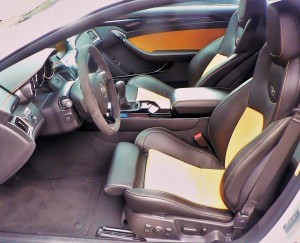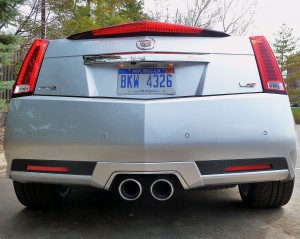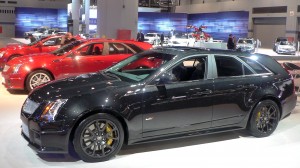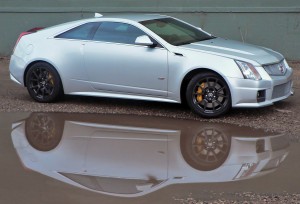CTS-V is NOT your grand-dad’s Cadillac
By John Gilbert
At first touch, you know you’re in a high-performance sports coupe. Hit the ignition and a lot of power roars to life. Click the 6-speed manual shifter into first gear, let out the clutch, and as it engages, hammer the gas pedal, resulting in a tremendous surge forward — exhilarating, in fact. This is not only power, it’s supercharged power, measuring 556 horsepower and 551 foot-pounds of torque.
The steering wheel feels thick and substantial to your grip, although if it’s real leather, it is “sueded” to the point of feeling artificially fuzzy. It is easy to grip, the easier to hang onto, as you upshift smoothly into second. You get to second in what seems to be very sudden elapsed time, and while hitting the throttle again gets you up into the revs quickly before you hit third, then fourth, the power surges at each new gear and each new tap of your right toe.
Now you sweep through a curve, and the steering and suspension feel well-matched, and as the Recaro bucket seat grips your body as perfectly as your hand grips the wheel, you carve an easily prescribed line through the curve. Very impressive, and outright fun. It would have the same appeal to an aging hot-rodder as the blatant musclecars of 40 years ago, but with so much more refinement that you don’t ever consider calling it retro.
No, it is not a hot-rod in the traditional sense. Turns out, it’s a Cadillac. But not just any Cadillac, either. This is the new CST-V Coupe, a car that began life on the auto show circuit as one of those dream concepts that, it seemed,would never reach production stage, not with General Motors falling toward its bankruptcy bottoming-out a few years ago. The CST-V is what one of those hot-rodders from a previous era might demand to own if they’d grown up and become wealthy, without ever losing the memory of the thrill of hot cars.
The powertrain is behind the scenes, although it’s never too far behind anything, really. The tailpipe trumpets tip off what’s in the CTS-V, for those unaware of what the lettered badges mean. In the 2011 CTS-V, it means a 6.2-liter V8, with a supercharger fitted on to slam a force-fed blast of air into the intake manifold, sucking in large quantities of premium fuel in order to make 556 horsepower.
Who would have ever thought that Cadillac would venture into the hot-rod business? Even if they’re recovered nicely, with the government bailout loan and reorganization, we might not have foreseen the building of such high-performance rockets on the rebound. Cadillacs always have meant stately luxury cars, usually on the very large side. When the CTS came along, it was a nicely chiseled midsize car, appropriate for the era of less ostentatious conveyances.
It still fits that description of chiseled and properly downsized to midrange, but for 2011, you can find it in a couple of different derivations — a station wagon, and a coupe. Both the wagon and the coupe take the chiseled look to new heights of attractiveness. You can get it with rear-wheel drive or all-wheel drive, and while some purists will demand the rear-drive layout, having AWD makes it more attractive to those who live in the snow belt.
Then there is the CTS-V. This was aimed directly at competing with the hottest autobahn screamers from German luxury car-makers. Cars such as the BMW “M” models, Mercedes with its AMG performance branch, and Audi, with its “S” versions, have owned that segment. The CTS-V fits well, from a pure performance standpoint, as well as by looks, and handling, and price.
You’ll spend over $60,000 to obtain your own proof that a U.S. luxury car-builder can build something so very German-like. The test-drive vehicle I had for a week was $69,440 after adding over $7,000 of options, mainly the genuine Recaro butt-clinging seats, the 19-inch satin-graphite wheels, through which you can see yellow brake calipers on the usually-red Brembo brakes, and the “midnight Sapele wood trim” package, as well as the “sueded steering wheel and shifter.” The promo blurb doesn’t say where you might find “sapele” wood, or whether you must harvest it at midnight, nor does it say “suede leather,” saying only “sueded.” Somebody said it was real leather, but its fuzziness leaves me skeptical.
The suspension is exceptional, using the magnetic ride control GM came up with for its Corvette and Cadillac XLR sports cars a decade ago. It has little tiny metallic slivers floating around in a substance inside the shock absorbers, so that when the computer senses a turn, it also senses if it’s sharp or abrupt, and instantly it signals the electromagnetis shocks to snap those slivers to attention, thus firming the shock. You don’t know all that’s going on, of course, you only know that this Cadillac puts to rest the old notion that Cadillacs are so soft they have to have plenty of lean and roll to prove it. This buggy stays flat, through the tightest turns.
You can get the CTS without the “V” and it is an impressive, real-world car on its own, with a direct-injection version of the 3.6-liter V6, with its dual overhead camshafts and four valves per cylinder. That has 304 horsepower and 273 foot-pounds of torque — more than enough to zip the Coupe around, even if it does weigh 4,000 pounds.
Moving up to the CTS-V, though, will get prompt and continual notice. My son Jack, who assists me on test-drives and shoots some photos as well, noticed on his first drive around town that people noticed the car. “I was stopped twice by people who wanted to take pictures of the car,” he said. Jack’s other comment matched my impression. “There’s so much power, but it didn’t feel brutish that way some cars do,” he said. “And the transmission was great — no skip-shift.”
Two issues here. First, in GM’s “BB” days — before bankruptcy — all other GM brands used pushrod V8s and pushrod V6es, but to set Cadillac apart, its engineers developed a high-tech, 4.6-liter V8, with dual-overhead-cams and four valves per cylinder. Maybe that was just to silence the many critics, this one included, who bemoaned the fact that GM was the only major manufacturer left in the world that compromised technology for expense in every case. Using pushrods to run from the crankshaft up to the valvetrain limited the engines’ ability to rev as high, and made it work harder at fewer RPMs.The only reason was cost, by all accounts.
Cadillac later came up with the 3.6 V6, and had a perfect complement. Despite the fact that overhead cam engines cost more to build and to develop, GM allowed versions of that “Northstar” V8 to trickle down to other branches, and the 3.6 finally, and thankfully, replaced the raspy 3.8 pushrod V6es in all other lines.
When the XLR first came along as a two-seat sports car, it had the high-tech overhead cam engines, which set it apart. Even the Corvette still used the traditional old pushrod “small block” V8 it had popularized, and it was always less expensive to simply make that engine larger and larger in displacement. I once challenged Cadillac engineers that they could make the XLR more powerful than the Corvette, because they had the great potential of dual overhead cams at their disposal. Finally one high-ranking engineer said, “You just wait.” Not long after that, an amazing supercharged version of the 4.6 V8 was introduced, and the XLR indeed could challenge the Corvette for supremacy, despite having more than one full liter less in displacement.
It was, of course, extremely costly. So it is with mixed feelings that I note the engine in the CTS-V. It is a derivative of the Corvette pushrod V8, now at 6.2 liters, with pushrods instead over overhead cams. When I asked why, I was told that General Motors no longer produces the 4.6-liter Northstar V8. It has gone the way of the Dodo bird, the Oldsmobile, and the Saturn, not necessarily in that order.
GM engineers have done an amazing job of finding ways to extract enormous quantities of horsepower out of those pushrod V8s, and the Corvette now has a 7-liter version, along with the supercharging trick.
Most consumers won’t realize that when they hammer the CTS-V, leaving behind all sorts of other high-performance cars, it also leaves behind a little bit of technology. In the process, fuel economy takes a hit, too. EPA estimates are 14 miles per gallon city, 19 highway, and we couldn’t get it over 18.
The transmission is perhaps the most significant improvement. You can get a Hydramatic 6-speed automatic, but if you think front-engine/rear-drive performance cars deserve a stick shift, try the 6-speed manual. Starting with the Corvette, and finding its way to Camaro and other GM high-performance vehicles, GM engineers learned to fool the EPA fuel economy computers with something called a skip-shift. If you started up hard, the shifter went from first to second easily, but if you started up moderately, when you went to shift from first to second, the shifter would be diverted to the right and land in fourth. If you weren’t paying attention, you would just think that your giant engine had no torque anymore.
If you were paying attention, it was maddening, especially if you were like I am, and like to start out moderately, then hit second before stepping on it hard to run the revs up. Every time, I would go first to fourth, and have to wrestle the shifter back into second, accompanied by a torrent of well-chosen words. To me, it would be a deal-breaker if I’d been considering purchase of any such car.
Cadillac has gotten wise and installs an Aisin AY6 manual transmission in the CTS-V. You can rev it high or low in first, and still go right into second. Smooth and slick. Aisin, a Japanese firm, builds those transmissions in Mexico. Hooked up to the blown 6.2 V8, it is a perfect match, and you can extract all those gobs of power in evrey gear.
The CTS-V standard equipment includes Stabilitrak, GM’s name for stability control, 10-way power seats for both driver and front passenger, high-intensity discharge adaptive headlights, foglights, Bluetooth, headlight washers, front-side-head curtain airbags,

Genuine Recaro bucket seats are unparalleled, furry steering wheel is...different. (Photo by Jack Gilbert.)
rear-vision camera, and — after years of pushing its OnStar system only — now you can get an actual navigation system as well. Options include a 10-speaker Bose digital surround audio system, factory remote start, sunroof, and a 40-gig hard drive.
If you think it’s a bit much to get giant-engine power in a Cadillac Coupe, it probably is. If the practical side says it’s overdone and too much power for a quite-small coupe, it definitely is. Just remember, if the practical side gets too pushy, you could always switch to the CTS-V Wagon — a sinister-looking, low-slung station wagon that can meet any family’s daily chores to the grocery store or for hauling kids. Just remember, with the same supercharged power, the CTS-V Wagon will get the groceries or the kids home in record time.
Comments
Tell me what you're thinking...
and oh, if you want a pic to show with your comment, go get a gravatar!





 John Gilbert is a lifetime Minnesotan and career journalist, specializing in cars and sports during and since spending 30 years at the Minneapolis Tribune, now the Star Tribune. More recently, he has continued translating the high-tech world of autos and sharing his passionate insights as a freelance writer/photographer/broadcaster. A member of the prestigious North American Car and Truck of the Year jury since 1993. John can be heard Monday-Friday from 9-11am on 610 KDAL(www.kdal610.com) on the "John Gilbert Show," and writes a column in the Duluth Reader.
John Gilbert is a lifetime Minnesotan and career journalist, specializing in cars and sports during and since spending 30 years at the Minneapolis Tribune, now the Star Tribune. More recently, he has continued translating the high-tech world of autos and sharing his passionate insights as a freelance writer/photographer/broadcaster. A member of the prestigious North American Car and Truck of the Year jury since 1993. John can be heard Monday-Friday from 9-11am on 610 KDAL(www.kdal610.com) on the "John Gilbert Show," and writes a column in the Duluth Reader.